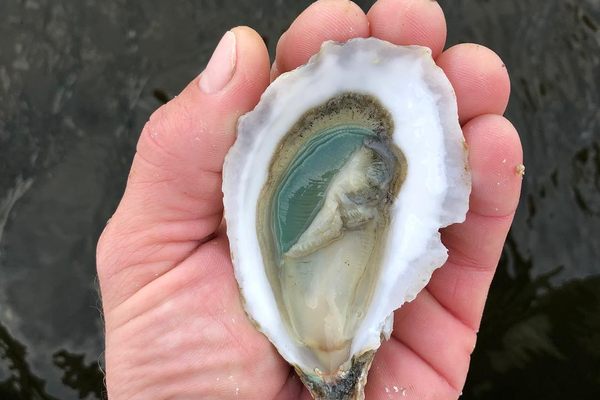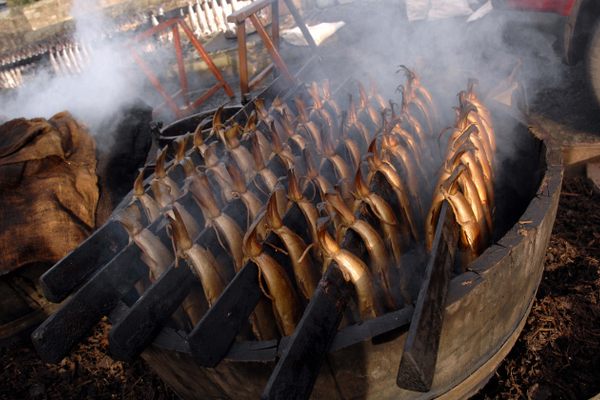Prepared Foods
Espardenyes
Catalan chefs transform the slimy, bottom-feeding sea cucumber into subtle, succulent meat.
What crawls along the bottom of the ocean, protects itself by wearing a layer of thick mucus, resembles a walking pickle, and is absolutely delicious grilled up or in paella? It’s the sea cucumber, of course.
More specifically, it’s Parastichopus regalis, a species that can be found slurping across ocean floors in the Mediterranean Sea and Atlantic Ocean. Once consumed mainly by seafaring folk and poor fishing villages on the coast and islands of Spain, the edible part of the creature—the meat around its digestive system—is now a highly prized delicacy.
Known as espardenyes in Catalonia and Valencia (named after a style of traditional peasant footwear worn across Spain), a pound of properly cleaned, succulent sea cucumbers might set you back $80 or more. The texture of prepared Mediterranean espardenyes can be likened to raw squid or to razor clams, but with a less intense oceanic flavor than other seafoods. Their subtle, earthy taste and pleasurable mouthfeel make for a perfect accompaniment to larger dishes, such as seafood paella. Some chefs may also grill the morsels with garlic and parsley, a style known as a la Bilbaína used in other seafood dishes, such as angulas.
There are more than 1,500 species of sea cucumber worldwide, but only a few of them are commonly served on a plate. While Mediterranean varieties may liven up rice dishes in Valencia, similar creatures can be eaten raw in Japan, cooked with mushrooms in Indonesia, or even used medicinally in China. For creatures that waddle slowly across the ocean floor on tiny stumps, they sure do get around.
Where to Try It
-
This Valencia restaurant is known for its espardenyes.
-
Paco Meralgo
C/ Muntaner 171, Barcelona, 08036, SpainSome say the espardenyes at this Barcelona tapas establishment are pricey but worth it.
Written By
 JamesRUDD
JamesRUDD
Sources
- metropoli.elmundo.es/blogs/cuadernomatoses/2016/04/29/espardenyes-textura-y-misterio-en-el.html
- billsinclair.es/sea-slugs-sea-snails-spicy-spuds-and-cheesy-flowers/
- translate.google.es/translate?hl=en&sl=es&u=www.verema.com/foros/restaurantes/temas/1000129-espardenya-pepino-mar-delicias-mediterraneo&prev=search
- translate.googleusercontent.com/translate_c?depth=1&hl=en&prev=search&rurl=translate.google.es&sl=es&sp=nmt4&u=www.pescaderiascorunesas.es/mariscos/espardena&xid=17259,15700022,15700105,15700124,15700149,15700168,15700173,15700201&usg=ALkJrhgVE6yjcGgHA1ie45zCt-ZQ9XQymg
- www.researchgate.net/publication/232998945_Sea_Cucumber_in_the_Mediterranean_A_Potential_Species_for_Aquaculture_in_the_Mediterranean
- www.thespruce.com/sea-cucumber-overview-695159
- www.iucnredlist.org/details/180298/0
- books.google.com/books?id=pWHhCgAAQBAJ&pg=PA62&lpg=PA62&dq=sea+cucumbers+espadrilles&source=bl&ots=YINUmgfGrx&sig=ZqQV4pCML4auVES7xNtfql_n7Vo&hl=en&sa=X&ved=0ahUKEwiLrbXqh5DaAhWHrVkKHVwQDO0Q6AEIgAEwCw#v=onepage&q=sea%20cucumbers%20espadrilles&f=false
- billsinclair.es/sea-slugs-sea-snails-spicy-spuds-and-cheesy-flowers/












